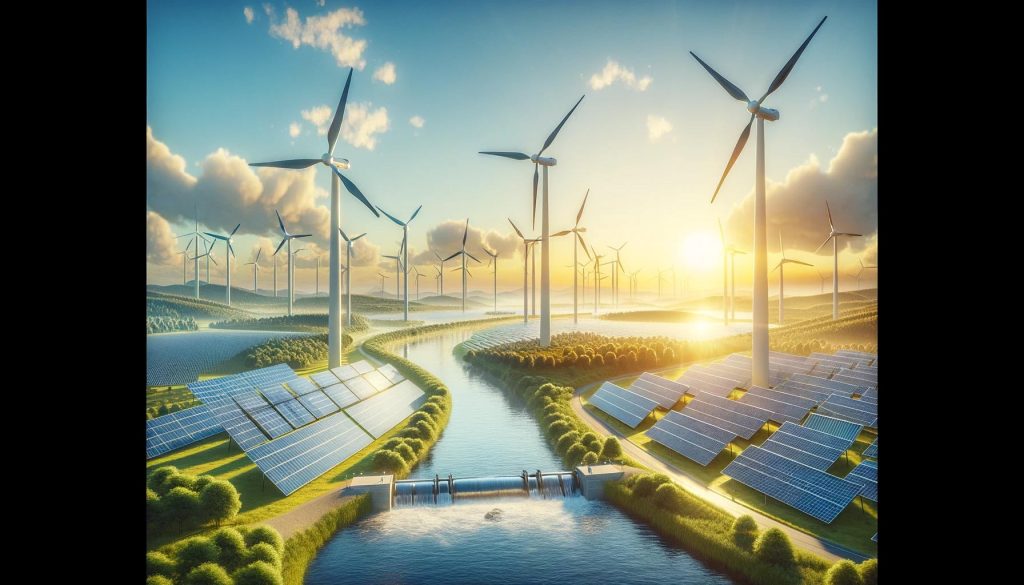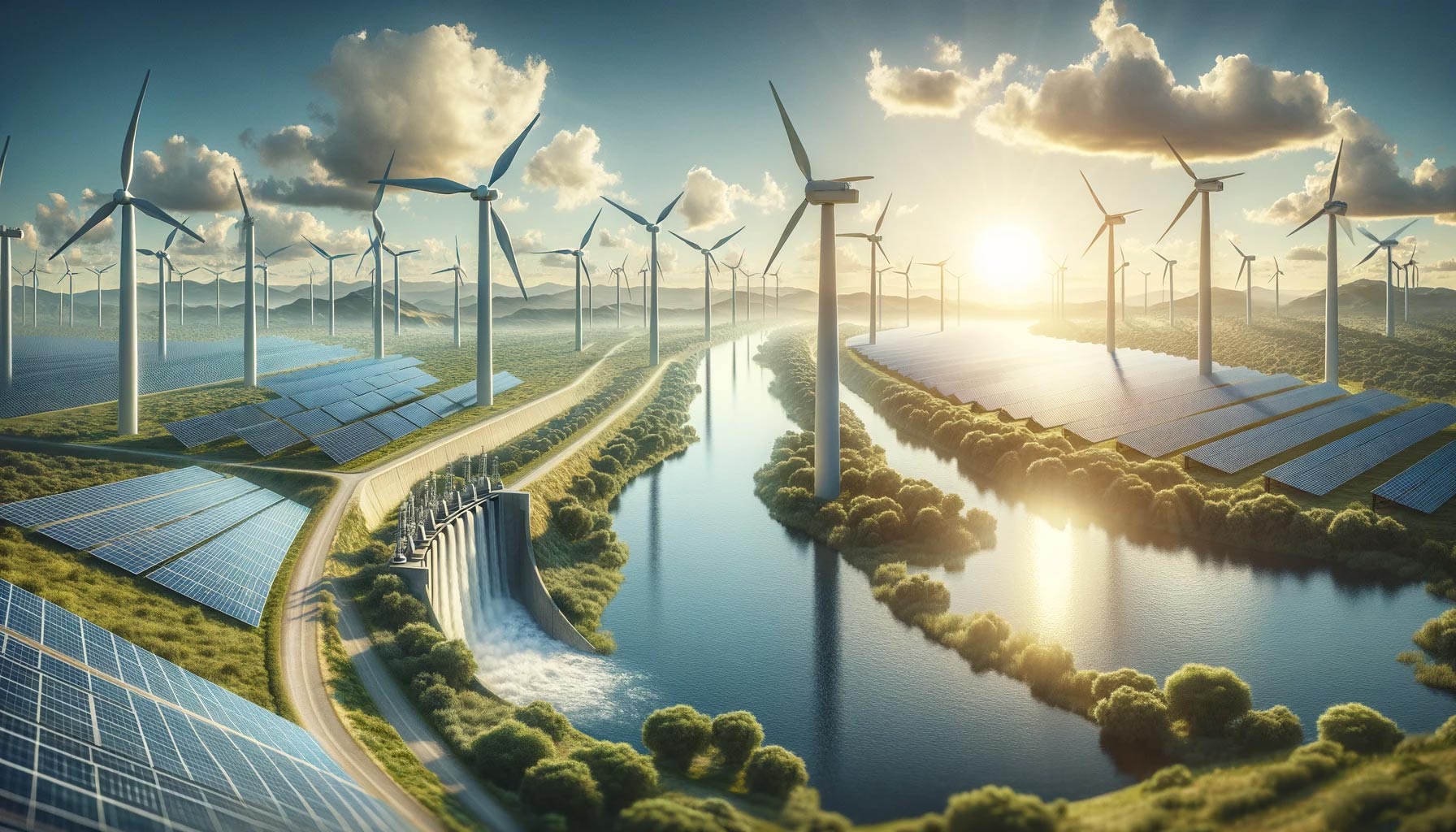In an increasingly energy-hungry world, the search for sustainable and efficient energy sources has become more critical than ever. As we face the challenges of climate change and the need to reduce greenhouse gas emissions, the choice of the right energy source for powering both big metropolises and small towns is paramount. In this article, we’ll delve into the key renewable energy options—solar, wind, hydro, tidal, biomass, and geothermal energy and compare their merits, drawbacks, and suitability for different urban settings. So, which one is truly the best?
1. Solar Energy
Solar energy is harnessed from the sun’s rays using photovoltaic cells or solar panels. It’s a widely adopted renewable energy source for both big cities and smaller communities.
Pros:
- Abundant sunlight in many regions.
- Scalable for urban rooftops and solar farms.
- Low maintenance.
- Reduces electricity bills and reliance on the grid.
Cons:
- Intermittent energy production (daylight-dependent).
- High upfront installation costs.
- Energy storage required for nighttime use.
- Environmental concerns during production.
2. Wind Energy
Wind energy involves converting the kinetic energy of wind into electricity using wind turbines. It’s a promising option for various urban environments.
Pros:
- Renewable and sustainable.
- High energy production in windy regions.
- Reduced greenhouse gas emissions.
- Potential for offshore wind farms.
Cons:
- Intermittent energy source.
- Aesthetic and noise concerns.
- Initial investment and maintenance costs.
- Limited feasibility in low-wind areas.
3. Hydro Energy
Hydro energy utilizes the gravitational force of flowing water to generate electricity. It’s a well-established source for cities with access to rivers or dams.
Pros:
- Reliable and constant energy production.
- Low operational costs.
- Long lifespan of hydroelectric plants.
- Acts as flood control and water supply.
Cons:
- Environmental impact on aquatic ecosystems.
- Limited availability in dry regions.
- High upfront infrastructure costs.
- Vulnerable to droughts.

4. Tidal Energy
Tidal energy harnesses the gravitational pull of the moon on ocean tides to generate electricity. It’s a niche but promising source for coastal cities.
Pros:
- Predictable and consistent energy generation.
- Low carbon footprint.
- Minimal visual and noise pollution.
- Low operating costs over time.
Cons:
- Limited geographic applicability (coastal areas only).
- High initial setup costs.
- Impact on marine life.
- Requires specialized technology.
5. Biomass Energy
Biomass energy derives from organic materials such as wood, crop residues, and waste. It can be suitable for smaller communities with access to biomass resources.
Pros:
- Readily available in agricultural regions.
- Carbon-neutral if managed sustainably.
- Utilizes organic waste.
- Can provide rural employment opportunities.
Cons:
- Limited energy output compared to other sources.
- Emissions during combustion.
- Competition with food production.
- Reliance on consistent biomass supply.
6. Geothermal Energy
Geothermal energy taps into the Earth’s internal heat for electricity and heating. It’s a viable option for regions with geothermal reservoirs.
Pros:
- Steady and consistent energy production.
- Low environmental impact.
- Suitable for heating and cooling.
- High efficiency.
Cons:
- Limited to geothermal hotspots.
- Initial drilling and exploration costs.
- Risk of depleting the reservoir.
- Geological uncertainties.
Comparing the Best Energy Sources
The choice of the best energy source for powering cities depends on several factors, including geographic location, energy demand, environmental concerns, and budget constraints.
- Urban Density: Solar and wind energy are adaptable to densely populated areas, while hydro and geothermal may require larger land or water bodies.
- Reliability: Hydro and geothermal offer steady power, while solar and wind have intermittent generation patterns.
- Environmental Impact: Tidal and geothermal have lower environmental footprints, while biomass and hydro can have significant ecological effects.
- Initial Costs: Solar and wind tend to have higher upfront costs, while biomass and hydro can be more affordable to set up.
- Local Resources: Biomass relies on local organic materials, whereas tidal and geothermal are location-dependent.
- Carbon Emissions: Biomass and geothermal are low in emissions, whereas others vary in their environmental impact.
- Scalability: Solar and wind can be easily scaled up, while tidal and geothermal may require specific geographical conditions.
Which one is more suitable and less expensive for home use?
When it comes to choosing a renewable energy source for home use, several factors come into play, including suitability and cost-effectiveness. Let’s take a closer look at some of the most common renewable energy options for residential use:
Solar Energy: Solar panels are a popular choice for home use. They are highly suitable for residential areas, especially if you have a roof with good sun exposure. Solar energy systems can be cost-effective in the long run, as they can significantly reduce or eliminate your electricity bills. The initial installation cost can be high, but there are government incentives and financing options available to help offset these costs.
Wind Energy: Small wind turbines can be used for home energy generation, but they are less common than solar panels. Wind energy is more suitable for homes in areas with consistent and strong wind patterns. Initial setup costs for residential wind turbines can be relatively high, and maintenance is required.
Hydro Energy: Hydroelectric systems for home use are generally limited to properties with access to flowing water, such as a stream or river. These systems can be cost-effective in the right location but may require a significant upfront investment for installation.
Geothermal Energy: Geothermal heat pumps are used for heating and cooling homes. While they are highly energy-efficient and environmentally friendly, the initial installation cost can be higher than conventional heating and cooling systems. Geothermal systems are most suitable for areas with a moderate climate.
Biomass Energy: Biomass heating systems use organic materials like wood pellets or agricultural waste for home heating. These systems can be cost-effective if you have access to a consistent biomass supply, but they require storage space for fuel and regular maintenance.
In terms of suitability and cost-effectiveness for home use, solar energy often stands out as a reliable option for many homeowners. It can be installed on rooftops, requires minimal maintenance, and can generate electricity for both residential needs and feeding excess power back into the grid, potentially earning you credits or income through net metering programs.
The suitability of each renewable energy source will depend on your location, budget, available resources, and energy needs. It’s essential to conduct a thorough assessment, including an evaluation of your property’s characteristics and energy consumption patterns, before making a decision. Additionally, consider consulting with renewable energy professionals to determine the best solution for your specific circumstances.
Conclusion
In conclusion, there is no one-size-fits-all answer to the question, “Which one is the best energy source?” Each renewable energy option has its advantages and drawbacks, making them suitable for different urban scenarios. The choice should be based on a comprehensive evaluation of local conditions and needs. Ultimately, a mix of these energy sources and continued technological advancements will pave the way for a sustainable energy future in both big and small cities.
FAQ‘s
What is renewable energy?
Renewable energy is energy derived from natural sources that can be naturally replenished, such as sunlight, wind, and water.
How do solar panels work?
Solar panels convert sunlight into electricity through photovoltaic cells, generating clean and renewable power.
Are renewable energy sources eco-friendly?
Yes, renewable energy sources are eco-friendly because they produce little to no greenhouse gas emissions, reducing environmental impact.
What are the benefits of wind energy?
Wind energy reduces reliance on fossil fuels, lowers electricity bills, and decreases carbon emissions.
Can I use geothermal energy for home heating and cooling?
Yes, geothermal heat pumps can efficiently heat and cool homes by tapping into the Earth’s stable underground temperatures.

